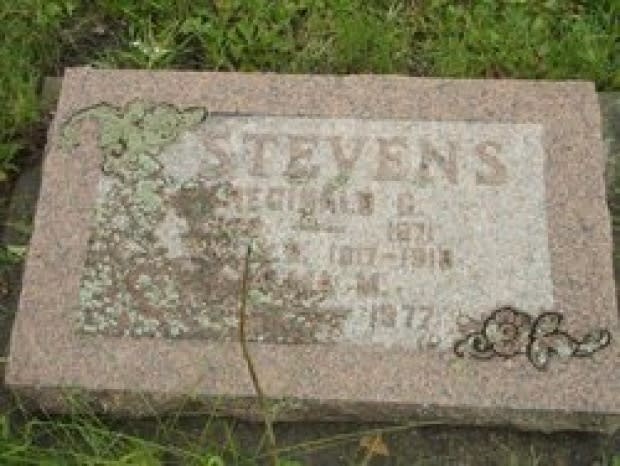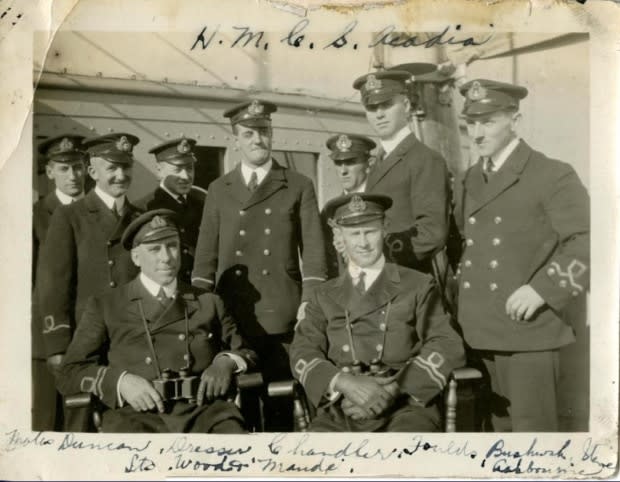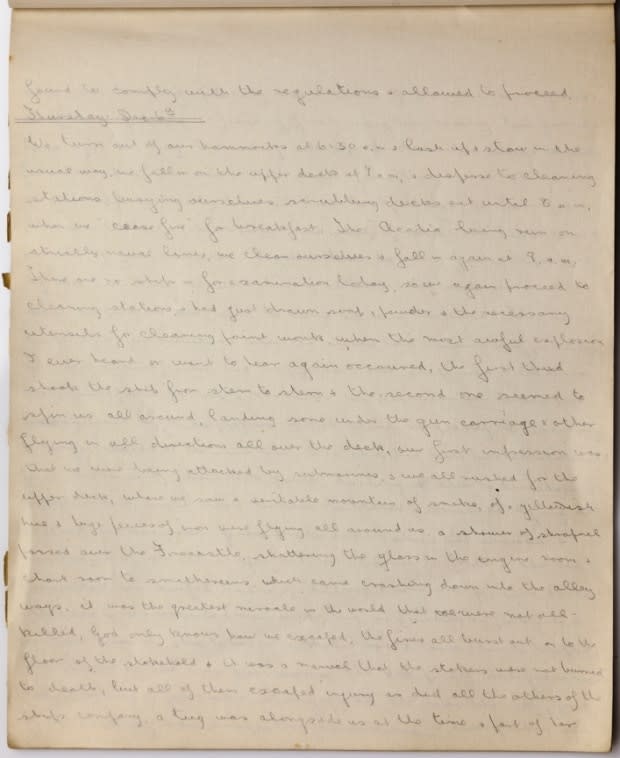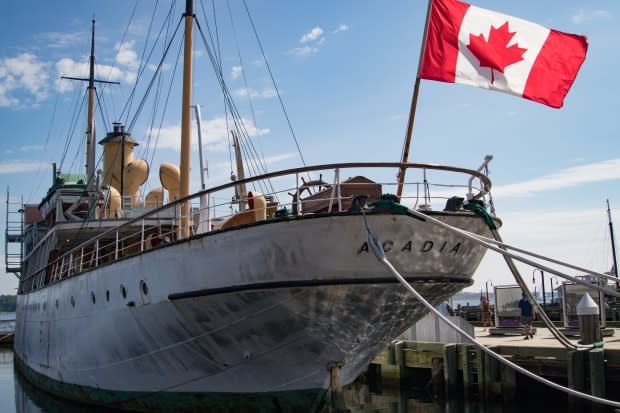New clue unlocks mystery of Halifax Explosion photo

A surprise twist in the investigation into a new image of the Halifax Explosion has found the exact spot the photo was taken.
Amazingly, the ship from which Mate Reginald Stevens took his "surreal nightmare" of a photo not only survived the 1917 disaster — it still floats in Halifax harbour today.
Jeff Noakes, a historian at the Canadian War Museum in Ottawa, saw the image when it was posted to Reddit and again when CBC News reported on the photo's existence.
Noakes found an entry in the January 1918 Canadian Navy List of personnel that shows Mate Stevens had been assigned to HMCS Acadia a few weeks before the explosion.
"Historical photographs, I think for a lot of people, are fascinating just because they literally can be a window into the past," Noakes says.

Stevens survived the war and married Alma Kerr in Ontario in 1919. He died in 1971, buried with his wife in the New Liskeard Pioneer Cemetery in New Liskeard, Ont. His headstone notes his military service from 1917 to 1918, something he still cherished all those decades later.
Noakes said a direct report, perhaps Stevens telling the story of the photo in a newspaper, or another sailor noting his presence on the ship that morning, would further confirm that he was on the Acadia.
The Maritime Museum of the Atlantic says the Acadia was guarding the east side of the entrance to the Bedford Basin on Dec. 6, 1917. It was anchored about 600 metres offshore from where the Bedford Institute of Oceanography sits today.
That's exactly where the Imo was departing from, and to where the Mont Blanc was headed on that busy morning in the harbour.
Historian Joel Zemel even found an archival photo of Stevens on the Acadia, likely taken months after the explosion.

Zemel also tracked down the diary of Frank Baker, an English sailor who served as a patrolman on the Acadia, checking for hidden cargo and spies, according to the Dartmouth Heritage Museum. He would have been near Stevens when the explosion hit and likely standing near him as he took the photo.
Eyewitness to disaster
Baker's neat handwriting belies the chaotic scenes he describes. For Thursday, Dec. 6, Baker writes that everyone was up out of their hammocks at 6:30 a.m. to lash up and stow away. He got on the upper deck at 7 a.m. and got busy scrubbing the decks "until 8 a.m., when we 'cease fire' for breakfast," he wrote. The crew cleaned themselves and fell in line at 9 a.m., minutes before the explosion.
He had no scheduled ship examinations that day, so he drew soap and powder to clean the paint work, "when the most awful explosion I ever heard or want to hear again occurred," he wrote. "The first thud shook the ship from stem to stern and the second one seemed to spin us all around."
Some men were thrown under the gun carriage and others blasted right off the deck. The crew thought German submarines were attacking them.
A 'mountain of smoke'
"We saw a veritable mountain of smoke of a yellowish hue and huge pieces of iron were flying all around us. A shower of shrapnel passed over the forecastle, shattering the glass in the engine room and chart room to smithereens, which came crashing down into the alleyways," he wrote.
"It was the greatest miracle in the world that we were not all killed. God only knows how we escaped."
Stevens's photo captures that mountain of smoke.

The Acadia caught fire, but they soon put it out and no one was hurt. A hail of shrapnel crashed down 20 metres from the Acadia. "This came with such force that had it struck us we should certainly have all been lost, it was so terrific."
That was the explosion's last effort and, five minutes after the astonishing eruption, it was over. Only after a few minutes, when the smoke had cleared, could they see what had happened: a collision between two ships.
Many ships were on fire and hundreds of small craft had been "blown to hell." Baker described a sea floating with debris and wreckage.

Zemel was already skeptical about Steven's claim that he took the photo "30 seconds after explosion."
"Frank Baker's diary entry creates a real problem regarding the timeframe. According to the diary entry, it was not safe to be on deck within the five minutes following the initial blast with all the pandemonium occurring around and inside HMCS Acadia. As such, the 30 second window is extremely unlikely," he says.
It was more likely taken a few minutes after the explosion.
All Ships on Fire
And one last twist. When the photo first surfaced on Reddit, one user did a reverse image search and found it only appeared one other time on the entire internet: as the album cover for a San Francisco indie musician called Baktria.
Baktria told CBC he usually uses his own photography for his albums, but "wanted something a little more literal for this one."
"I came across the image in question through a series of searches on fair use, copyright-free image databases," he wrote. The credit mentioned the Halifax Explosion, but he knew little of that event. It just fit his work perfectly.
The album's name? All Ships on Fire, a title that could fit the photo, too.
MORE TOP STORIES


